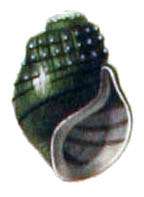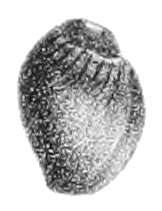Plicate rocksnail
| Plicate rocksnail | |
|---|---|
 | |
| 1842 drawing of the shell of Leptoxis plicata by Jean-Charles Chenu. | |
| Scientific classification | |
| Kingdom: | Animalia |
| Phylum: | Mollusca |
| Class: | Gastropoda |
| (unranked): | clade Caenogastropoda clade Sorbeoconcha |
| Superfamily: | Cerithioidea |
| Family: | Pleuroceridae |
| Genus: | Leptoxis |
| Species: | L. plicata |
| Binomial name | |
| Leptoxis plicata Conrad, 1834[2] | |
| Synonyms | |
|
Anculotus plicatus Conrad, 1834 Anculotus plicata Conrad | |
The plicate rocksnail, scientific name Leptoxis plicata, is a species of freshwater snail with a gill and an operculum, an aquatic gastropod mollusk in the family Pleuroceridae.
This species is endemic to the United States, specifically the state of Alabama. The snail has been listed as endangered on the United States Fish and Wildlife Service list of endangered species since October 28, 1998.[3]


Description
The plicate rocksnail is a pleurocerid snail with a shell that grows to about 20 mm (0.8 in) in length. Shells are subglobose with broadly rounded apertures. The body whorl may be ornamented with strong folds or plicae. Shell color is usually brown, occasionally green, and often with four equidistant color bands. The columella (central column or axis) is smooth, rounded, and typically pigmented in the upper half. The aperture is usually bluish-white, occasionally pink or white.[4]
The operculum (plate that closes the shell when the snail is retracted) is dark red, and moderately thick.[4][5]
Although morphologically similar to the basin's other three surviving rocksnail species, the plicate rocksnail is genetically distinct.[4][6]
Distribution
The plicate rocksnail historically occurred in the Black Warrior River, the Little Warrior River, and the Tombigbee River.[4][5]
Recent status surveys have located plicate rocksnail populations only in an approximately 88 km (55 mi) reach of the Locust Fork of the Black Warrior River, Jefferson and Blount counties, Alabama.[7] The latest survey information indicates that the snail has recently disappeared from the upstream two-thirds portion of that habitat and now appears to be restricted to an approximately 32 km (20 mi) reach in Jefferson County.[4][8][9]
Reasons for the decline
The Plicate rocksnail has disappeared from more than 90 percent of its historic range. The curtailment of habitat and range for this species (and a few other snail species) in the Mobile Basin's larger rivers - (Black Warrior River, the Little Warrior River, and the Tombigbee River for the Plicate rocksnail) is primarily due to extensive construction of dams, and the subsequent inundation of the snail's shoal habitats by the impounded waters. This snail has disappeared from all portions of its historic habitats that have been impounded by dams.[4]
Dams change such areas by eliminating or reducing currents, and thus allowing sediments to accumulate on inundated channel habitats. Impounded waters also experience changes in water chemistry, which could affect survival or reproduction of riverine snails. For example, many reservoirs in the Basin currently experience eutrophic (enrichment of a water body with nutrients) conditions, and chronically low dissolved oxygen levels.[10][11] Such physical and chemical changes can affect feeding, respiration, and reproduction of these riffle and shoal snail species.[4]
Ecology
Habitat
Plicate rocksnails inhabit shallow gravel and cobble shoals in the flowing waters of rivers.[4]
Life cycle
Although the precise longevity has not been well documented, individuals have survived 2 years in captivity.[12]
References
This article incorporates public domain text (a public domain work of the United States Government) from the reference.[4]
- ↑ Bogan, A.E. 1996. Leptoxis plicata. 2006 IUCN Red List of Threatened Species. Downloaded on 07 August 2007.
- ↑ Conrad T. A. 1834. New Fresh water Shells. Page 61, plate 8, figure 18.
- ↑ Fish and Wildlife Service. (October 28) 1998. Endangered and Threatened Wildlife and Plants; Endangered Status for Three Aquatic Snails, and Threatened Status for Three Aquatic Snails in the Mobile River Basin of Alabama. Federal Register, Vol. 63, No. 208, Rules and Regulations, Accessed 26 January 2009.
- 1 2 3 4 5 6 7 8 9 U.S. Fish and Wildlife Service. 2005. Recovery Plan for 6 Mobile River Basin Aquatic Snails. U.S. Fish and Wildlife Service, Jackson, Mississippi. 46 pp. pages 13-14 and page 15.
- 1 2 Goodrich C. 1922. The Anculosae of the Alabama River Drainage. Miscellaneous Publications, Museum of Zoology, University of Michigan (7):1-57.
- ↑ Lydeard C., W.E. Holznagel, J. Garner, P. Hartfield & J. M. Pierson. 1997. A molecular phylogeny of Mobile River drainage basin pleurocerid snails (Caenogastropoda: Cerithioidea). Molecular Phylogenetics and Evolution 7(1):117-128.
- ↑ Service Field Records, Jackson, Mississippi, 1991, 1992; Malcolm Pierson, Calera, Alabama, Field Notes, 1993 in U.S. Fish and Wildlife Service. 2005. Recovery Plan for 6 Mobile River Basin Aquatic Snails. U.S. Fish and Wildlife Service, Jackson, Mississippi. 46 pp. pages 13-14.
- ↑ Garner in litt., 1998
- ↑ Johnson P.D. 2002. An inventory of Leptoxis plicata, the plicate rocksnail in the Locust Fork of the Black Warrior River, Jefferson County Alabama. Preliminary report to the US Fish and Wildlife Service, Jackson, MS. 22 pp.
- ↑ Alabama Department of Environmental Management. 1994. Water quality report to Congress for calendar years 1992 and 1993. Montgomery, Alabama. 111 pp.
- ↑ Alabama Department of Environmental Management (ADEM). 1996. Water quality report to Congress for calendar years 1994 and 1995. Montgomery, Alabama. 144 pp.
- ↑ P. Johnson, Tennessee Aquarium Research Institute, pers. comm., 2002 in U.S. Fish and Wildlife Service. 2005. Recovery Plan for 6 Mobile River Basin Aquatic Snails. U.S. Fish and Wildlife Service, Jackson, Mississippi. 46 pp. pages 13-14.
